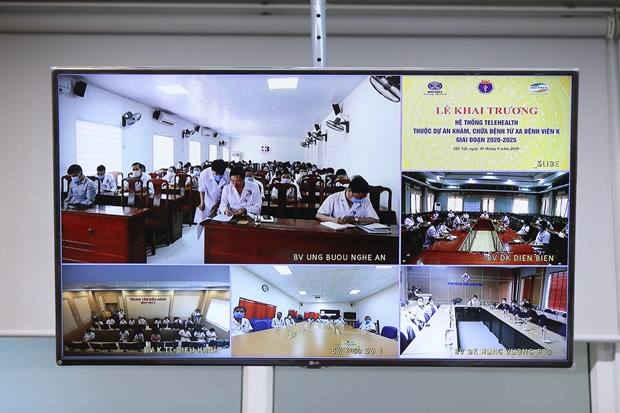 Society
Society

The Ministry of Health is implementing a remote medical examination and treatment project for 2020-2025 to ensure the sustainable development of the health sector.

|
| Remote medical examination and treatment has been deployed in many hospitals such as Hanoi Medical University Hospital, National Children's Hospital, Hanoi Heart Hospital, etc. to connect to dozens of hospitals in provinces across the country. |
The Ministry of Health is implementing a remote medical examination and treatment project for 2020-2025 to ensure the sustainable development of the health sector.
The system has been deployed in many hospitals such as Ha Noi Medical University Hospital, National Pediatric Hospital, Ha Noi Heart Hospital and K (Cancer) Hospital. It is estimated that when implemented nationwide, it will save the health sector tens of thousands of billions of đồng each year.
Professor Lương Ngọc Khuê - Director of the Medical Examination and Treatment Department under the Ministry of Health, talked to VietnamPlus online newspaper about the project
Could you tell us about the aims of the project?
The remote medical examination and treatment project is one of the focuses of the Ministry of Health at this time to build an unlimited medical network between all levels of health care facilities nationwide.
Counselling and support for the grassroots levels is one of the tasks of training and direction of central and upper-level hospitals. This is an activity that has been implemented in a number of medical examination and treatment facilities. However, during the COVID-19 pandemic and amid emerging diseases, there are new risks, requiring the health sector to take drastic measures to meet both epidemic prevention and socio-economical development goals.
The project is built to help strengthen the professional capacity of the lower level hospitals, to help them achieve higher quality of treatment.
The project’s goals are that all people will be consulted, examined, treated, and professionally supported by doctors from the communal to the central level; and that people can use higher-quality health care services at lower-level medical establishments. Staff of medical facilities will receive regular and irregular professional support from higher-level hospitals based on information technology. This will contribute to disease prevention, reducing hospital overcrowding at higher levels, as well as improving the quality, efficiency and results of medical examination and treatment.
Could you tell us more about remote medical consultation and treatment?
During the COVID-19 pandemic prevention period, the Ministry of Health has applied information technology solutions to implement remote treatment counselling and treatment. The National Steering Committee has established a centre for management and administration to support professional diagnosis and treatment of COVID-19 patients.
The centre regularly organises online conferences and invites leading professors across the country to consult on serious cases, discuss optimal treatment methods for patients and share treatment and care experiences. Information technology has helped bring together the team of leading experts and hospitals closer together and there is almost no geographic distance between regions and between the upper and lower levels.
The establishment of such a management and administration centre marked the development of the medical examination and treatment system in the trend of applying advanced scientific and technological achievements in disease treatment, especially with the COVID-19 pandemic.
This further confirmed the effectiveness of information technology in implementing remote treatment and counselling activities. The case of the British pilot, patient 91, is a typical example. Leading experts regularly held online conferences to find the best solutions for treatment and thanks to that, the patient made a miraculous recovery.
The management centre for diagnosis and treatment of patients COVID-19 was built and developed in the first days when the outbreak began and had been recognised as one of seven works that were honoured in the Golden Book of Vietnamese Creativity by the Central Committee of the Viet Nam Fatherland Front.
According to the project, the first phase of the remote medical examination and treatment project will set up 1,000 points connecting health professionals. How will this work?
The COVID-19 professional support management and management centre for patient diagnosis and treatment is a testament to the success of remote consultation and is the model that will be multiplied across the country. To maintain and keep it efficient, it requires a series of legal corridors and policies.
Specifically, we need strict management from information security, transmission lines, technical lists for health insurance billing and regulations to make the consultation opinions at the upper level become a legal basis and necessary for the lower level to implement.
The Department of Medical Examination and Treatment was assigned as the focal point to co-ordinate with the departments of the Ministry of Health and the Departments of Information Technology under the Ministry of Information and Communication. Viettel will implement many solutions to ensure the legality of a remote consultation meeting as well as ensuring the technical elements for remote consultation and treatment are effective.
Currently, there are nearly 20 central hospitals able to conduct remote examination and treatment, of which Bạch Mai Hospital has connected with 300 points, Việt Đức Hospital connected with nearly 130 points and Medical University Hospital connected with nearly 200 points.
A total of 1,000 points is the number that the project aims for. Currently there are 40 central hospitals nationwide; 492 provincial hospitals; 645 district hospitals; 72 hospitals of each sectors in the society; 275 private hospitals; 32,000 private clinics; and 11,000 medical stations. With such a foundation, this number of 1,000 points for remote medical examination and treatment is completely feasible. – VNS




